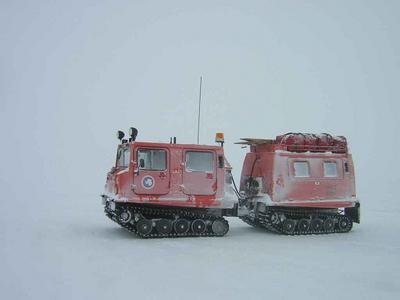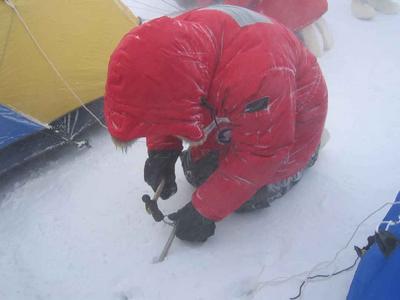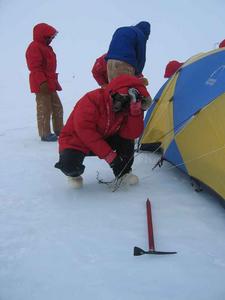
|
|
13 October, 2003
Condition 1. That about sums up today. The weather in Antarctica is classified as one of
three conditions. Condition 3 is defined as having winds of less than 48 knots, wind chill
warmer than –75F, and visibility greater than 1/4 mile. Not exactly balmy and beautiful,
but certainly tolerable. To experience Condition 2 you will have any combination of wind
speeds greater than 48-55 knots, wind chills of –75 to –100F, or visibility of less than 1/4
mile. Condition 1, the baddest of the bad, has any combination of wind speeds greater
than 55 knots, wind chills colder than –100F, or visibility less than 100 feet. I can safely
say that I now know what Condition 1 feels like.
I have always been a fan of intense weather (is it because I grew up in Buffalo?), so
today’s Condition 1 experience was exciting and memorable. The statistics say it all.
Winds peaked at 75 knots (to change this to miles per hour, multiply by 1.2), and stayed
around 45 knots for much of the afternoon. Windchill reached –58F. Visibility was
definitely confined to a few inches in front of your face. Now this is weather!
So, where were we when we experienced Condition 1? We were out on the sea ice,
parcticipating in yet another orientation program, Sea Ice Training. We had traveled out in
a Haggland—another interesting Antarctic tracked vehicle. The objective of this
orientation is to teach us how to collect data about the sea ice that will enable us to travel
safely in areas with cracks. In addition, the class teaches how to put up tents on the ice
(how do you stake a tent down to 12 feet of solid ice?) if you are faced with a survival
situation. The intensity of the weather definitely made the second objective a relevant
training. Have you ever wondered how many scientists it takes to stake down a tent on
the ice with winds gusting over 60 mph? Based on today’s experience I would have to
say 4 to 6 would be an ideal number. You need a couple people to stand on the tent
once it is removed from the stuff sack whole 2 others place ice screws into the ice to
anchor the corners of the tent firmly to the ice. Then, you need at least 2 people putting
the poles together and attaching them securely to the clips on the tent. Now, when it
comes to putting on the rain fly life gets a bit exciting. Imagine holding a large piece of
nylon fabric in a stiff wind with heavy gloves on your hands while you try to operate
plastic buckles and clips to secure it to the tent. All we needed was a long piece of string
and we could have flown around on a very special kite! The final step in securing the
tent to the ice involved drilling tie-down holes in the ice. Using an ice auger or an extra
snowstake, we drilled a series of paired holes—each pair was parallel to the edge of the
tent and angled to meet in the middle to create a channel in the ice through which we
threaded the tent tie-down cords. This step might be tricky in the best of conditions, but it
was really fun in the wind and blowing snow. It took patience and persistence, but
eventually we had the tent secured. Then what? We took the tent down (more fun in the
wind) and retreated to the relative comfort of the Sea Ice Hut.
While the storm raged outside we learned some of the finer points of sea ice formation
and travel safety evaluation. Each year Antarctica almost doubles in size due to the
growth of sea ice. Right now, in October, the sea ice is at its maximum and will reach its
minimum in February. Sea ice is a dynamic surface, moving and adjusting to stresses
from a variety of factors. These factors are divided into three main groups; environmental,
geographical, and mechanical. The movement of the ice as it reacts to these factors can
cause cracks or pressure ridges to form. Now, cracks are a great thing if you are a
Weddell Seal—they provide the seals access to the surface to get a gulp of air or to
reach the ice for pupping. If you are a researcher traveling, living, and working on the
sea ice, these cracks are definitely an attention-getter, since the water below is very cold
and it is doubtful that bunny boots and 4 layers of long underwear do much for flotation.
Due to the intensity of the storm, we were unable to complete the second part of the
class—drilling holes in the ice near cracks to evaluate stability. The US Antarctic
Program rule of thumb for safe ice travel requires a minimum of 30” of ice. Tomorrow we
will be heading back out to the ice to complete this important part of our training. I’m
hoping for a slightly less intense weather experience so that we can get out on the ice
and apply what we’ve learned.
Daily Haiku:
Sea ice training day
Condition one whiteout fun
Can you see the hut?

Setting out on the sea ice in the Haggland

Putting up the tents

Drilling holes for the tent tie-downs

Tying down the tent

Condition 1
Contact the TEA in the field at
.
If you cannot connect through your browser, copy the
TEA's e-mail address in the "To:" line of
your favorite e-mail package.
|
